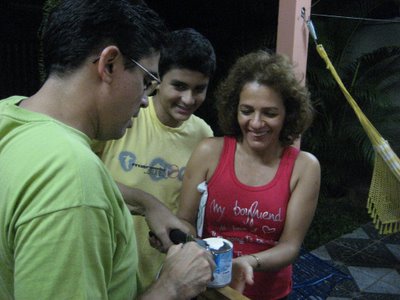According to church rules, in order to attend the making of Ayahuasca, you must follow a strict diet; no sex or alcohol three days prior to the work and three days after. During the work you must only eat macaxeira, cooked manioc root (like a potato type product that is the main subsistence for the indigenous tribes that live further into the jungle), and drink either water or Ayahuasca. During the work, which takes place in a building close to the church structure, hymns are either sung or recorded hymns are played.
First, the vine, Jagube (Banisteria caapi), is gathered, either locally or some distance out of town. It is cut into small sections and placed next to a piece of tree trunk, which acts like a table. There are six tree trunk tables with small stools all lined up on one side of the open walled structure. There are large wooden mallets resting on the dirt floor. The men (women were absent from this work, however I suspect that they were the ones who cooked the macaxeira…) take their places and begin to pound in rhythm to the music. From what I’ve heard (Matt made sound recordings) it sounds hypnotic. Once a section of vine is pounded out thin, it is tossed into the middle of the room, where a person will come along ever so often and gather them up. They are then taken to the cooking room, where a large stone oven is surging with flames. There are three large holes on top of the oven, this is where the large vats will cook for hours.
Once there is a good amount of pounded Jagube, the cook will layer a large vat with Jagube vine, and folha (Psychortia viridis leaves); these layers will be built up, one layer after another, until they reach just about half the vat. Water is then added and the mixture will be left to cook with a periodic stirring until the liquid is a warm amber-brown color. Once this color is achieved, the liquid is poured through a large sieve. The cooked vine and leaves are toss out and the liquid is added to another vat that has fresh vines and leaves for another long cooking period. This makes the tea a nice robust dark honey brown color. Once the tea is cooled it is then poured into gallon containers and taken to a storage area to await the next concentration or hinario. The tea, prepared in a ritualized place and process, has been prayed over and made according to the rules of the church, it is no longer considered Ayahuasca, but now, goes under the name Daime.









